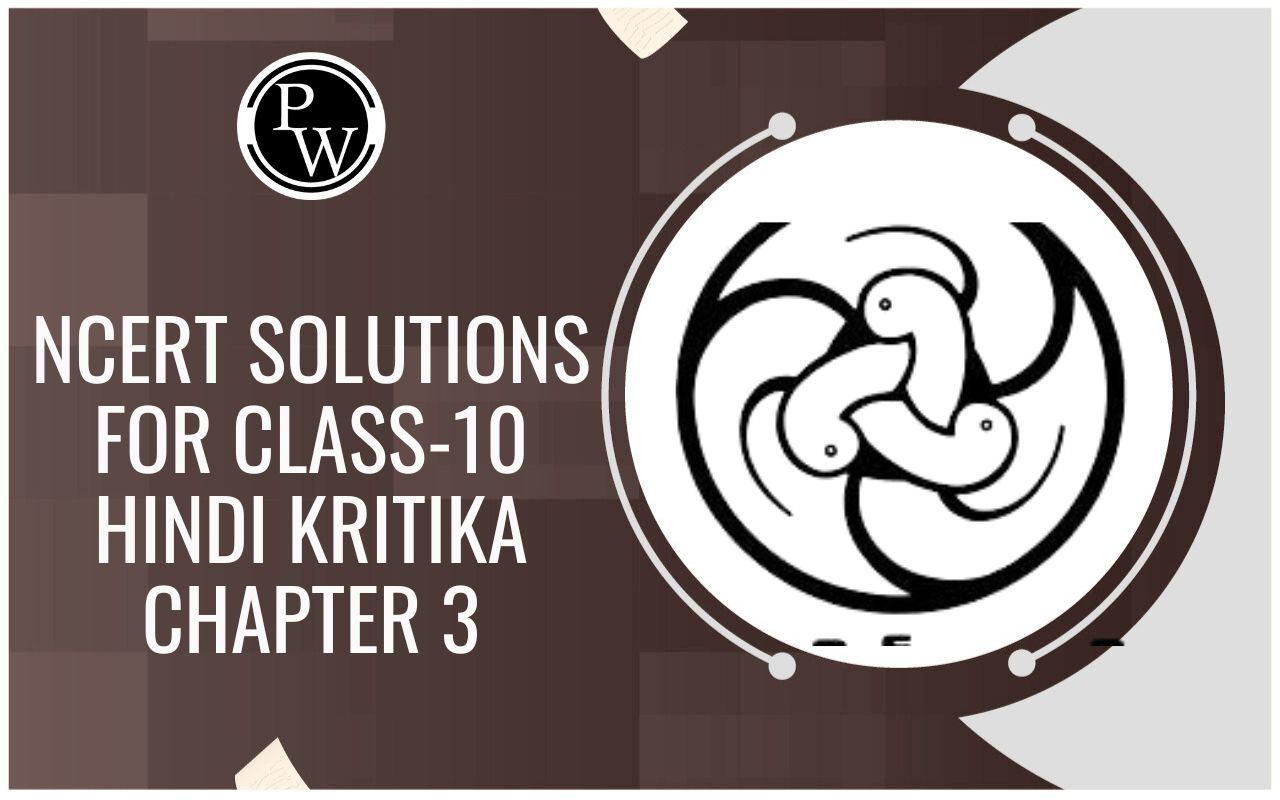
Structure of Human Skeleton
Body Movements of Class 6
Structure of Human Skeleton:
The human skeleton or skeletal system is made up of 206 bones. A new born baby has 300 bones. But as it grows, some of the bones fuse together or join. Thus the number reduce from 300 to 206.
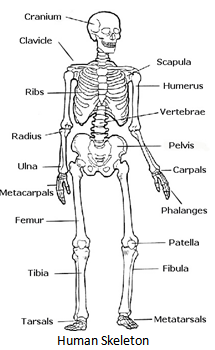
Functions of Skeleton
The important functions of skeleton are as follows:
- Skeleton holds the whole body together and gives it a shape.
- Skeleton protects many delicate internal organs of the body (such as brain, heart, lungs, liver and spinal cord) from outside damage.
- Skeleton provides numerous points for the attachment of muscles of the body.
- Alongwith muscles, skeleton helps in the movement of body parts and locomotion (walking, etc).
Illustration 2: What do you mean by fracture and dislocation in bones?
Solution: Bones may crack or are completely broken in an accident. Such injuries are called fractures. Bones can also move from the original position called dislocation.
Parts of the skeleton
Skull
The bony part of our head is called skull. It is called ‘khopri’ or ‘Kapli’ in Hindi.
The bones of the skull are the hardest of all the bones. Cranium is the box like structure around the brain.
The rest are facial bones which give shape to the face. Two bony sockets are formed by facial bones in which our eyes balls are protected. All the bones of the skull are fixed and only the lower jaw is movable which help us to eat and speak.
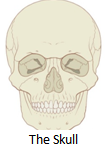
Function of Skull:
- Skull protects the brain.
- Skull protects the sense organs of the face (like eyes, ears and nose)
- Skull gives shape to our head.
Illustration 3: How many total bones are present in the human skeleton?
Solution: 206
Backbone
The backbone or the vertebral column extends from the base of the skull to the hip. It is also known as spine. This backbone and the strong back muscles help us to stand erect. The backbone is made up of 33 separate bones called vertebrae (singular Vertebra). These vertebrae are ring like and are joined end to end. The first 24 are jointed serially by cartilage. Thus it forms a hollow long tube like structure through which the main nerve cord (spinal cord) passes. The last nine vertebrae are joined together and do not move.

Illustration 4: Which tissue is present between the vertebrae?
Solution: Cartilage
Functions of Backbones
- Backbone provides main support to the body.
- Backbone supports the head at its top.
- Backbone attaches shoulder bones, ribs and hip bone.
- Backbone protects the spinal cord.
Rib Cage
Running through the centre of the chest is the breastbone or sternum. Joined to it are strong, curved, flexible bones called ribs. The ribs are thin, flat, bones that form a protective cage around the heart and lungs. This is called the rib cage. The rib cage consists of 24 bones arranged in 12 pairs. All of them are joined to the backbone.
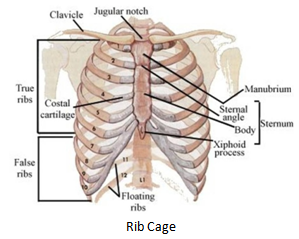
Functions of Rib Cage
- Rib cage protects the internal organs of the body such as heart, lungs and liver.
- Rib cage takes part in our breathing movements.
Shoulder Bone
Shoulders are that part of the body (or skeleton) to which our arms are attached. There are two shoulder bones: Collar bone and shoulder blade. The upper arm fits into the socket of shoulder blade forming ball and socket joint.
Functions of the Shoulder Bone
- Collar bones on the two sides of the neck keep our shoulders apart.
- Shoulder blades attached the arms to our body.
- Shoulder blades provide sites for muscle attachments which move the arms, neck and upper part of our body.
Hip Bone
The hip bone forms a large, basin-shaped frame at the lower end of the backbone, to which the legs are attached. The hip bone is also known as pelvic bone (or pelvis). The thigh bones of our legs are joined to the hip bone by the ball and socket joint.
Functions of Hip bone
- Hip bone supports and protects the lower organs of the body such as intestine, urinary bladder and internal sex organs.
- Hip bone attaches the legs to our body.
- Hip bone provides sites for the attachment of muscles that move legs, hip and trunk.
Bones of the hands
Our hand is made up of three parts: wrist, palm and fingers. The wrist consists of 8 small bones known as carpals. The palm of hand is composed of 5 longer bones called metacarpals. The fingers (including thumb) are made of jointed bones called phalanges. There are 3 bones or phalanges in each finger but the thumb has only 2 bones (or phalanges). The wrist bones (carpals) form movable joint with the bones of forearm. Due to this our wrist is flexible. The palm bones (metacarpals) form movable joints with fingers. The finger bones (phalanges) form movable joints among themselves. There are five fingers in our hand including the thumb. The thumb is shorter than other fingers.
Cartilage
At some places in the skeleton there is a material which is not as hard as bone and which can be bent. It is called cartilage. Cartilage is much softer than bone. Cartilage can be bent without breaking. In fact, cartilage is a kind of softer and elastic bone. Cartilage is present in the following places in our body:
(i) Cartilage is present in the pinnae of ears (upper part of ears).
(ii) Cartilage is found at the end of nose.
(iii) Cartilage is found on the end of bones where they meet one another at a joint.
(iv) Cartilage is also present (as cartilage discs) between the vertebrae of backbone.
Joints
A place where two or more bones join is called a joint. Bones are joined by tough, flexible bands of elastic tissue called ligaments. Joints are of two types - fixed and movable.
Depending on the type and extent of movement they allow, movable joints can be further classified into different types.
Fixed Joints: Some joints, for example, between the bones of the cranium, do not allow any movement. These are fixed joints. The joints between the teeth and the jaw bones are also fixed, as also are the joints between the bones that make up the hip bones.
Ball and Socket Joints: These joints allow the greatest freedom of movement or are the most mobile. In such joints, the rounded head of one bone fits into the hollow, cup-shaped socket of another. The bone that fits into the socket is free to move in all directions around the joint. The joint of the upper arm and the shoulder bone is an example of this type of joint. That is how a bowler can lay his arm or a swimmer can rotate his arms freely. The hip joint is another ball and socket joint.
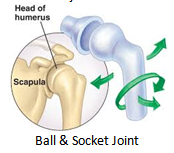
Hinge Joints: These joints work like a door hinge or a penknife. In this type of joint, the convex (slightly bulging) surface of one bone fits into the concave (slightly depressed) surface of another bone, allowing movement in only one direction. For example, the hinge joint at your elbow allows you to bend your forearm and straighten it. It does not let you bend your arm backwards or sideways. The same is true of the knee joint.
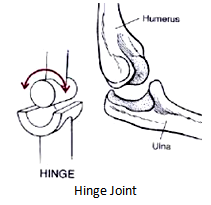
Pivot Joints
In such joints, a bony ring rotates around a pivot (axis), or stick like bone. This allows twisting movement about the joint. The head moves from side to side because it rests on a pivot joint at the top of our spine.
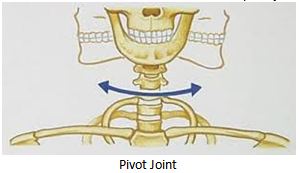
Gliding Joints
Such joints occur between the vertebrae and between the bones of the wrists and ankles. The cartilage between these bones allows small movements, somewhat like the movement. During movement, one bone slides over the other.
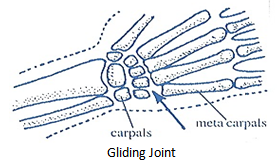
Illustration 5: Give two examples of fixed joints.
Solution: Bones of skull, Upper Jaw
Illustration 6: Give two examples of ball and socket joint
Solution: Joint of hips and shoulders



